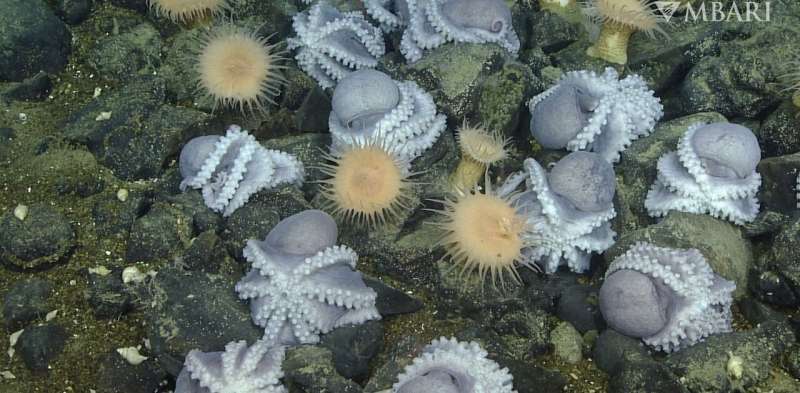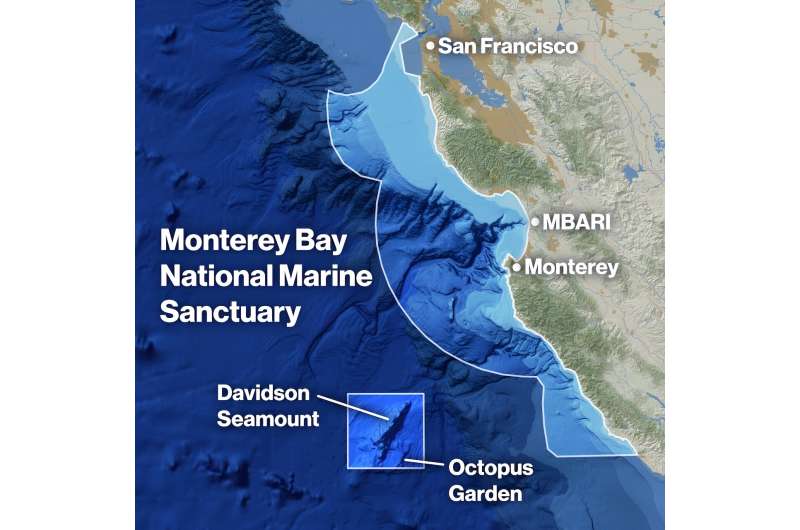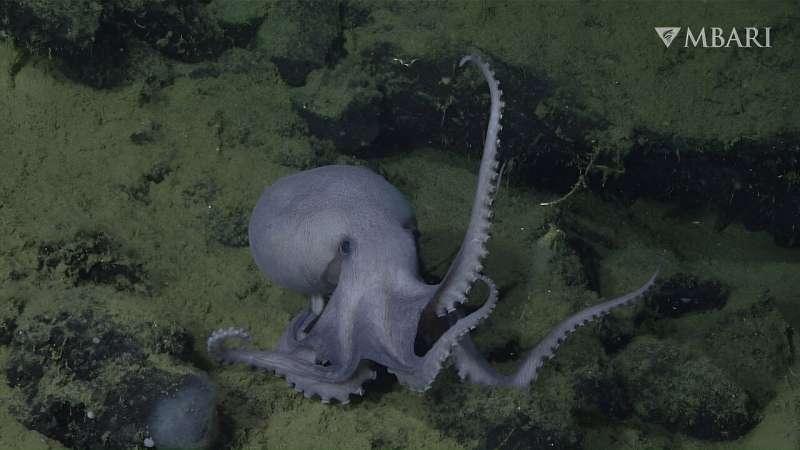Secrets of an octopus’s garden: Moms nest at thermal springs to give their young the best chance for survival

Two miles below the ocean surface off Monterey, California, warm water percolates from the seafloor at the base of an underwater mountain. It’s a magical place, especially if you’re an octopus.
In 2018, one of us, Amanda Kahn, was aboard the research vessel E/V Nautilus when scientists discovered the “Octopus Garden.” Thousands of pearl octopuses (Muusoctopus robustus) were curled up into individual balls in lines and clumps. As Nautilus Live streamed the expedition online, the world got to share the excitement of the discovery.
We now know why these amazing creatures gather at this and other underwater warm springs.
In a new study involving scientists from several fields, we explain why octopuses migrate to the Octopus Garden. It’s both a mating site and a nursery where newborn octopuses develop faster than expected, giving them the best shot at survival in the deep, cold sea. Our research is published in Science Advances.
Life in the Octopus Garden
Female octopuses seek out rocky cracks and crevices where warm water seeps from the rocks. There, they vigilantly guard their broods. Subsisting off their energy reserves alone, these mothers will never eat again. Like most cephalopods, they make the ultimate sacrifice for their offspring and die after their eggs hatch.
The Octopus Garden, at the base of Davidson Seamount about 80 miles (130 kilometers) southwest of Monterey, California, is the largest of a handful of octopus nurseries recently discovered in the Eastern Pacific. Many have been found near hydrothermal springs where warm water seeps from the seafloor.

We wanted to know what makes these environments so appealing for nesting octopuses.
To solve this mystery, we assembled geologists, biologists and engineers. Using Monterey Bay Aquarium Research Institute‘s deep-sea robots and sensors, we studied and mapped the Octopus Garden during several visits over three years to examine the links between thermal springs and breeding success for pearl octopuses. We found nearly 6,000 nests in a 6-acre (2.5-hectare) area, suggesting more than 20,000 octopuses occupy this site.
A time-lapse camera that kept watch over a group of nesting mothers for six months opened a window into the dynamic life in the Octopus Garden.
We witnessed male octopuses approaching and mating with females. We cheered for the successful emergence of hatchlings, which looked like translucent miniatures of their parents. And we mourned the deaths of mothers and their broods.
When a nest became empty, it was quickly filled by a different octopus mother. We saw that nothing went to waste at the Octopus Garden. Dead octopesus provided a vital food source for a host of scavengers, like sea anemones and snails.
Warmer water speeds up embryo development
A new generation of octopuses must overcome at least two hurdles before hatching.
First, they must develop from egg to hatchling. They start as opaque, sausage-shaped eggs cemented to the rocks. Over time, tiny black eyes, then eight little arms grow visible through the egg capsule. Second, crucially, they must not succumb to external threats, including predators, injuries and infections. The longer the incubation period, the greater the risk that an embryo might not survive to hatch.
For octopus species living in warm, shallow waters, brood periods are only days to weeks long. But a very different scenario plays out in the abyss. Near-freezing temperatures dramatically slow metabolic processes in coldblooded animals like octopuses. The longest-known brood period for any animal actually comes from another deep-sea octopus species, Graneledone pacifica, with a mother tending her nest for a remarkable 4½ years. An octopus nursery for this species was recently discovered off the west coast of Canada.
At Davidson Seamount, where ambient water temperatures are 35 degrees Fahrenheit (1.6 degrees Celsius), we would expect pearl octopus embryos to take five to 10 years, or possibly longer, to develop. Such an extended brooding period would be the longest known for any animal, exposing an embryo to exceptional risks.
Instead, temperature and oxygen sensors we were able to slip inside octopus nests documented a much warmer microenvironment around the eggs. On average, the temperature inside octopus nests was about 41 F (5.1 C), considerably warmer than the surrounding waters. We predicted that octopus embryos would develop faster in this warmer water.
Distinctive marks and scars helped us identify individual mothers. Over repeat visits we tracked the development of their brood. Although we did expect faster growth in the warm water, we were stunned to find that eggs hatched in less than two years. Nesting in thermal springs clearly gives pearl octopuses a boost.
But nesting in thermal springs is a potentially risky strategy. Once eggs are laid, they’re cemented to the rock. We know little of the thermal tolerance of pearl octopuses or their embryos, but even a short exposure to overly warm waters could be lethal to developing embryos, wiping out any hope of successful reproduction for that mother. Indeed, one of the first recorded deep-sea octopus nurseries may have experienced unpredictable fluid flow.
Nurseries highlight risks to seafloor habitat
The thermal springs at the Octopus Garden are part of a ridge flank hydrothermal system. Here, water percolating beneath the seafloor picks up heat from Earth’s mantle before it’s channeled out from volcanic rock outcrops like Davidson Seamount. These systems have become an emerging focus in seafloor geology, though only a few have been discovered so far.
Unlike hydrothermal vents, which form at ridge crests and belch plumes of hot water that are detectable hundreds of meters above the bottom, thermal springs on ridge flanks are cryptic. These springs seep warm water that dissipates only meters above the bottom, making them exceedingly difficult to find and only visible by a slight shimmer in the water.
Our yearlong recordings from thermal springs at the Octopus Garden demonstrate these may be stable environments, with the potential to release warm fluids for thousands of years. Such stability benefits not only pearl octopus, but also the community of life that thrives alongside the nesting mothers.

The recent discoveries of octopus nurseries off the Pacific coast of Costa Rica, also near hydrothermal springs, suggests these areas may be more common than previously thought. It also highlights that hydrothermal springs may be vital biological hot spots.
The deep sea is the largest living space on Earth, and that expansive size can hide the importance of localized hot spots like these. Davidson Seamount and its Octopus Garden are protected as part of Monterey Bay National Marine Sanctuary, but many more biological treasures like thermal springs may be at risk, especially as deep-seabed mining proposes to scrape large understudied swaths of seafloor. We hope the octopus mothers we’ve met at this nursery inspire everyone to rethink stewardship for the yet-undiscovered hidden gems that may be lost.
More information:
James P. Barry et al, Abyssal hydrothermal springs—Cryptic incubators for brooding octopus, Science Advances (2023). DOI: 10.1126/sciadv.adg3247
This article is republished from The Conversation under a Creative Commons license. Read the original article.![]()
Citation:
Secrets of an octopus’s garden: Moms nest at thermal springs to give their young the best chance for survival (2023, August 26)
retrieved 26 August 2023
from https://phys.org/news/2023-08-secrets-octopus-garden-moms-thermal.html
This document is subject to copyright. Apart from any fair dealing for the purpose of private study or research, no
part may be reproduced without the written permission. The content is provided for information purposes only.
For all the latest Science News Click Here
For the latest news and updates, follow us on Google News.

